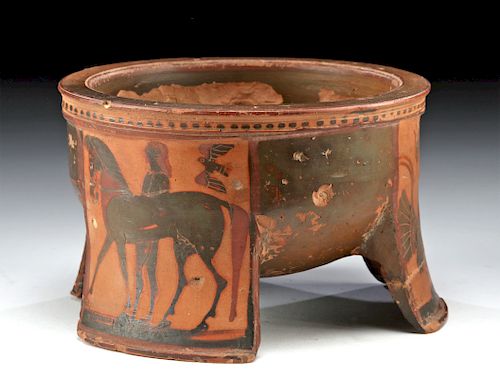Attic Black-Figure Tripod Pyxis, Ex Christie's
Lot 25a
About Seller
Artemis Gallery
686 S Taylor Ave, Ste 106
Louisville, CO 80027
United States
Selling antiquities, ancient and ethnographic art online since 1993, Artemis Gallery specializes in Classical Antiquities (Egyptian, Greek, Roman, Near Eastern), Asian, Pre-Columbian, African / Tribal / Oceanographic art. Our extensive inventory includes pottery, stone, metal, wood, glass and textil...Read more
Estimate:
$8,000 - $12,000
Absentee vs Live bid
Two ways to bid:
- Leave a max absentee bid and the platform will bid on your behalf up to your maximum bid during the live auction.
- Bid live during the auction and your bids will be submitted real-time to the auctioneer.
Bid Increments
| Price | Bid Increment |
|---|---|
| $0 | $25 |
| $300 | $50 |
| $1,000 | $100 |
| $2,000 | $250 |
| $5,000 | $500 |
| $10,000 | $1,000 |
| $20,000 | $2,500 |
| $50,000 | $5,000 |
| $100,000 | $10,000 |
| $200,000 | $20,000 |
About Auction
By Artemis Gallery
Sep 26, 2019
Set Reminder
2019-09-26 10:00:00
2019-09-26 10:00:00
America/New_York
Bidsquare
Bidsquare : Exceptional Day 1: Antiquities & Asian Art
https://www.bidsquare.com/auctions/artemis-gallery/exceptional-day-1-antiquities-asian-art-4437
Day 1 of an important 2-day auction featuring exceptional, museum-worthy examples of Egyptian, Greek, Etruscan, Roman, Viking, Russian, Near Eastern, as well as Asian Art from China, Japan, Thailand, Vietnam, Burma and India. Artemis Gallery info@artemisgallery.com
Day 1 of an important 2-day auction featuring exceptional, museum-worthy examples of Egyptian, Greek, Etruscan, Roman, Viking, Russian, Near Eastern, as well as Asian Art from China, Japan, Thailand, Vietnam, Burma and India. Artemis Gallery info@artemisgallery.com
- Lot Description
Ancient Greece, Athens, ca. mid 6th century BCE. A very special ceramic pyxis, its bowl-shaped receptacle upraised and supported by three slab-built legs with each face presenting a figural scene created via the black-figure technique - one featuring a pair of roosters facing one another, another with a sphinx comprised of the body of a lion, head of a woman, eagle wings, and according to some scholars a serpent's tail, and the third with a standing human behind a horse with a bird in flight behind the pair. Above these and encircling the rim of the vessel is a decorative dotted and incised frieze. Size: 5.5" W x 3.25" H (14 cm x 8.3 cm)
The iconography of this piece is very rich. According to legend, the gods sent the Sphinx to plague the town of Thebes as punishment for an ancient crime. This female monster preyed on its youths and devoured anyone who could not solve her riddle. King Kreon (Creon), the regent of Thebes, offered the throne to whomever could destroy her. Oedipus (Oidipous) rose to the challenge, and when he solved the Sphinx's riddle, she dramatically cast herself off the mountainside. Sphinxes were quite popular in ancient art - featured on grave stelae above the tombs of men who died in youth. When found adorning archaic vase paintings, they sometimes are included in a procession of animals and fabulous hybrid creatures such as bird-bodied sirens. Roosters were very popular in Greek visual culture as well. According to mythology, a rooster was standing beside Leto, who was pregnant by Zeus, at the moment she gave birth to Apollo and Artemis. By extension, the rooster is dedicated to solar gods and lunar goddesses. In addition, the rooster is an attribute of Apollo. The ancients would also ritually sacrifice a rooster to Asclepios, son of Apollo and god of medicine, because the rooster heralded the soul of the dead and guided it to the Otherworld. Asclepios by extension is also the god who, using his healing powers, brought the deceased back to life on earth.
Provenance: private East Coast, USA collection; Antiquities, Christie’s, London, 2 July 1982, lot 218
All items legal to buy/sell under U.S. Statute covering cultural patrimony Code 2600, CHAPTER 14, and are guaranteed to be as described or your money back.
A Certificate of Authenticity will accompany all winning bids.
We ship worldwide and handle all shipping in-house for your convenience.
#149771Two feet reattached. Chips to rim and peripheries of feet. Normal surface wear with nicks and abraded areas commensurate with age, but imagery on exterior is still nicely defined. Earthen encrustation on interior.Condition
- Shipping Info
-
All shipping is handled in-house for your convenience. Your invoice from Artemis Gallery will include shipping calculation instructions. If in doubt, please inquire BEFORE bidding for estimated shipping costs for individual items.
-
- Buyer's Premium



 EUR
EUR CAD
CAD AUD
AUD GBP
GBP MXN
MXN HKD
HKD CNY
CNY MYR
MYR SEK
SEK SGD
SGD CHF
CHF THB
THB

















